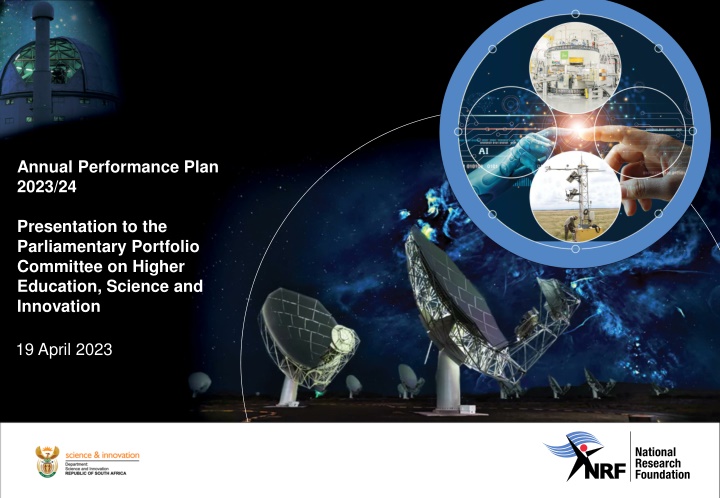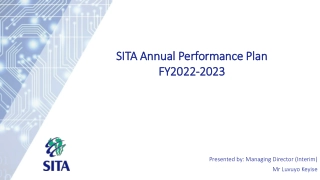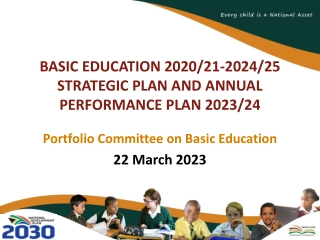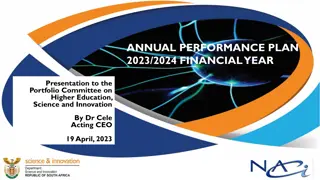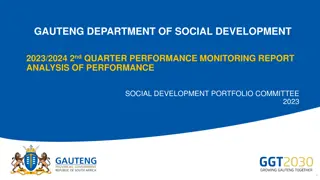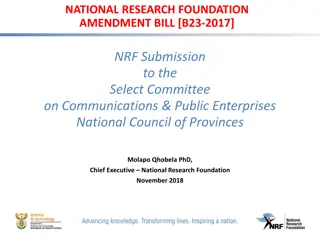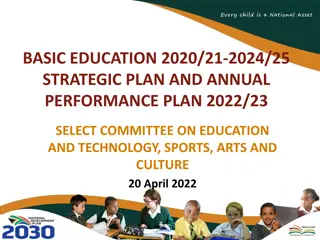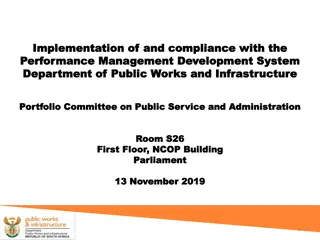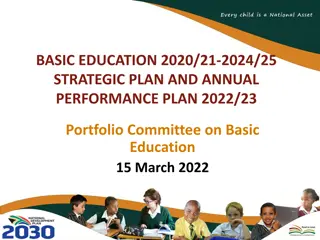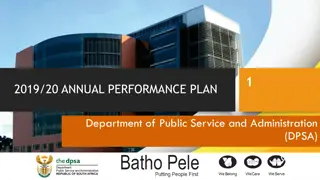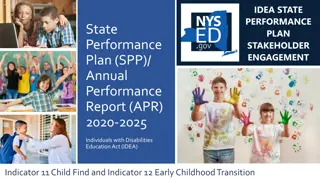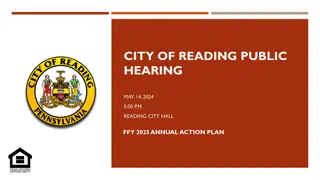NRF Annual Performance Plan 2023/24 Presentation Overview
This presentation to the Parliamentary Portfolio Committee on Higher Education, Science, and Innovation covers the NRF's mandate, strategic context, outcomes and indicators, key focus areas, financial overview, income sources, and funding trends. It emphasizes the NRF's role in advancing research, human capacity development, and national development through science and technology.
Download Presentation

Please find below an Image/Link to download the presentation.
The content on the website is provided AS IS for your information and personal use only. It may not be sold, licensed, or shared on other websites without obtaining consent from the author.If you encounter any issues during the download, it is possible that the publisher has removed the file from their server.
You are allowed to download the files provided on this website for personal or commercial use, subject to the condition that they are used lawfully. All files are the property of their respective owners.
The content on the website is provided AS IS for your information and personal use only. It may not be sold, licensed, or shared on other websites without obtaining consent from the author.
E N D
Presentation Transcript
Annual Performance Plan 2023/24 Presentation to the Parliamentary Portfolio Committee on Higher Education, Science and Innovation 19 April 2023
Presentation contents Recap of the NRF Mandate NRF Strategy 2025 Strategic context Overview of outcomes and indicators Annual Performance Plan (APP) 2023/24 Key focus areas for the MTEF period Overview of Programme 1- 4 performance Financial Overview Summary of Income & Expenditure 5-year trend NRF income sources 5-year trend Other sources of funding Concluding remarks 2
Recap on the mandate of the NRF mandate of the NRF The Object of the NRF is to contribute to National Development by: a) Supporting, promoting and advancing research and human capacity development, through funding and the provision of the necessary research infrastructure, in order to facilitate the creation of knowledge, innovation and development in all fields of science and technology, including humanities, social sciences and indigenous knowledge; b) Developing, supporting and maintaining National Research Facilities; c) Supporting and promoting public awareness of, and engagement with, science; and d) Promoting the development and maintenance of the national science system and support of Government priorities. 3
Strategic context NRF Strategy 2025 Overview of outcomes and indicators 4
Strategic context A transformed and agile knowledge organisation that shapes and influences all aspects of the research and knowledge enterprise, with unwavering commitment to transformation, impact, excellence and sustainability. Positioning of the NRF Transformation: The imperative for a better future. Key Impact: A better society through knowledge. Success Areas Excellence: The foundation that sets the standard. Sustainability: Building a better tomorrow today. Impact Statement National development enabled through advancing, promoting and supporting research. 5
NRF Strategy 2025 outcomes, indicators and targets Outcome. Outcome indicator Five year target YTD Progress Profile of NRF-funded post- Black 80% Black 78% (Black African increased from (57% to A transformed, graduate students who have 65% over 5yrs) internationally completed their studies Women 55% Women 58% (Black African women increased from competitive and (34% to 40% over 5yrs) Black 46% (Black African = 30%) Profile of NRF-funded Black 48% sustainable research researchers producing Women 42% Women 40% (Black African women = 10%) workforce research outputs Entrenchment of knowledge Portfolio of excellent research Research Impact Framework approved. and societal impacts in supported by the NRF Implementation Plan completed. excellent research supported justified with sound ex-ante Impact literacy campaign underway. by the NRF and ex-post Knowledge and Societal Impact Balanced portfolio of NRF Inclusive support of all Draft NRF Research Framework was compiled, and its Enhanced impact of the domains of science research investments across completion will be informed by completion of the STI research enterprise the knowledge domains Decadal Plan. Evidence-based decision- Improved organisational and The Information and Analysis (I&A) directorate was making to enhance the impact NSI analytics and its use in established. of the research enterprise strategic decision-making Research and Development Information Platform 6 (RDIP) design is complete. Analytics capabilities developed.
NRF Strategy 2025 outcomes, indicators and targets (cont.) Outcome Outcome indicator Five year target YTD Progress Engaged Research Framework (ERF) approved. Engaged science entrenched in A fully integrated science engagement the research enterprise programme which meets the needs of SAASTA has been reconfigured to fulfil a national coordination role of science engagement. the diverse NRF engagement chain Enhanced impact of science engagement (SE) Introduced grants for Science Shops in 2021 to support community-based research. Representation of designated Women 38% Women 30,9% groups in leadership, Black 55% Black 50% management, and supervisory (P1-7 occupational levels) All-inclusive employee Inclusive, enabling and learning Improvement on baseline survey s A transformed organisation survey concluded, and organisation results that lives its culture and Culture Improvement Plan values developed and currently Improvement on baseline survey s results A co-created culture enhancing being implemented. high performance and service excellence 7
Alignment to STI Decadal Plan NRF contribution to the revised MTSF and BPF Annual Performance Plan 2023/24 Key focus areas for the MTEF period Programmes indicators, targets and initiatives 8
Alignment to STI Decadal Plan The NRF will align current and future programmes to the STI Decadal Plan. A process is underway to re-imagine the RIISA programmes to align with and respond to the priorities of the Decadal Plan. Changes to be reflected in the 2024/25 APP. Changes to be phased in and aligned with funding availability. 9
NRF contribution to revised MTSF and BPF NRF contribution over the MTEF Revised MTSF and BPF Economic Transformation & job creation: NRF Supply Chain Transformation Framework completed. Improvements in various rating elements of the BBBEE scorecard at Level 4. NRF joined the YES programme as at 31 March 2023. Employment of local community members at NRF business units in rural areas (Northern Cape and Eastern Cape). Education: DSI-NRF Postgraduate Student Funding Policy. National Astrophysics & Space Sciences Programme (NASSP, R20m and +100 students annually). South African Institute for Nuclear Technology & Sciences (SAINTS). SARAO Human Capacity Development Programme. Skills: SARAO Artisan Training Programme. African Coelacanth Ecosystem Programme (ACEP)-Phuhlisa Programme. Health: Production of radio-isotopes by iThemba LABS for the diagnosis and treatment of cancer. SARChIs and CoEs in Health. Within the revised Medium Term Strategic Framework (MTSF) and Budget Prioritisation Framework (BPF), the NRF will be directly impacted by: Priority 2: Economic transformation and job creation. Priority 3: Education, skills and health DSI-led/ supported interventions/ indicators across outcomes (relevant to NRF). These are MTSF specific indicators DSI and NRF have been referenced in: Number of PhD students awarded bursaries through NRF and DSI. Number of pipeline postgraduate students awarded bursaries through NRF and DSI. 10
Key focus areas for the MTEF Transformation of postgraduate students and researchers through funding programmes that advance improved success, throughput and excellence. Drive infrastructure development to keep the NRF portfolio of Research Infrastructure Platforms (RIPs) globally competitive. Advance Science Engagement to enhance the impact of research and innovation. Review, refocus and expand partnerships for more industry involvement in research support. Advancing innovation and impact through research support and industry partnerships. Build on national and international partnerships to improve access to resources and research infrastructure. Create a culture that enhances high-performance. 11
Overview of NRF Programmes The NRF has four (4) Programmes: Programme 1: Administration. Programme 2: Science Engagement (SE). Programme 3: Research, Innovation and Impact Support and Advancement (RIISA). Programme 4: National Research Infrastructure Platforms (NRIP). 12
Programme 1: Administration indicators and targets Programme purpose: to provide support services and systemic enterprise-wide coordination Audited Actual Performance Estimate Annual Targets MTEF Period Outputs Indicators 2024/25 2025/26 2020/21 2021/22 2022/23 2023/24 A transformed leadership and management cohort Proportion of employees from designated groups at Peromnes levels 1-7 68% 53% 61% 64% 65% 67% Predictable and sustainable resourcing of the NRF mandate Outcome of annual audit by AGSA unqualified unqualified unqualified unqualified unqualified unqualified 13
Programme 1 : Key deliverables for the MTEF period Leverage local and international partnerships to increase resources. Build a high performance culture. Implement communication and stakeholder relations strategy. Develop and implement the NRF Digital Transformation Framework. Develop and implement the NRF Research Framework aligned to the STI Decadal Plan Priorities. Continue to enhance and optimise the Enterprise Resource Planning (ERP) system. Position the Research and Development Information Portal (RDIP) to address the requirements of the White Paper, the Decadal Plan, and NRF Vision 2030. 14
Programme 2: SE indicators and targets Programme Purpose: to transform the relationship between science and society. Audited Actual Performance Estimate Annual Targets MTEF Period Outputs Output Indicators 2024/25 2025/26 202021 2021/22 2022/23 2023/24 Number of public engagements with and in science interventions New New 12 12 13 13 Number of interventions supporting the development of skills for the future of work Science Engagement Interventions New New 14 16 18 18 Number of interventions to build SE capacity across the system New New New 4 5 5 15
Programme 2: Key deliverables for the MTEF period The NRF will focus on Science Engagement interventions as follows: Improve on public access to research infrastructure and science engagement platforms. Advance STEM education towards development of skills for work of the future. Building capacity and capability among stakeholders towards a decentralised Science Engagement Strategy execution national network coordinated by NRF. Implementation of an engaged research approach. 16
Programme 3 : RIISA indicators and targets Programme purpose: to provide support for research, innovation and human capacity development. Estimate Annual Targets MTEF Period Audited Actual Performance Outputs Indicators 2024/25 2025/26 2020/21 2021/22 2022/23 2023/24 NRF funded post-graduate Number of NRF funded post- graduate students 11 093 7 732 6 218 5 943 5 314 5 451 students NRF funded researchers Number of NRF funded researchers 3 000 3 201 3 000 3 612 3 000 3 000 NRF rated researchers Number of rated researchers New New New 4 452 4 586 4 723 17
Programme 3: Key deliverables for the MTEF period Maintain Postgraduate Student Funding Policy to enhance its effectiveness. Develop new programmes and review existing programmes to align with & contribute to the priorities in STI Decadal Plan. Provide support to develop a cohort of instrumentation scientists and technicians to secure skills requirements to develop, operate and maintain RIPs. Introduce tailored comprehensive capacity development initiatives for Historically Disadvantaged Institutions. Support provision of, and access to, RIPs and Research Equipment across the NSI. 18
Programme 4: NRIP indicators and targets Programme purpose: to provide leading-edge research infrastructure platforms for the science system. Audited Actual Performance 202021 Estimate Annual Targets MTEF Period 2024/25 Outputs Indicators 2025/26 2021/22 2022/23 2023/24 Socio-Economic contribution of NFs Foreign income (Rand million) derived from NFs activities R93 R107 R162 R234 R251 R280 Knowledge translation for societal benefit Number of patient doses generated from radioisotopes produced by iThemba LABS Number of technical and policy briefs produced or published by NFs. 143 793 171 713 200 000 220 000 253 000 316 250 New New 20 20 20 20 Knowledge produced for societal benefit Number of active intellectual property products New New 4 3 2 3 19
Programme 4: Key deliverables for the MTEF period Continue with: Roll out by SARAO of SKAO work packages for implementation of SKA1-MID. Implementation of the MeerKAT Extension Project by SARAO. Roll out of the South African Polar Research Infrastructure by SAEON. Prototyping of research infrastructures for SSH domain (History, Culture & Heritage. Poverty, Inequality & Unemployment & Digital Research Infrastructures). Infrastructure development work in fulfilment of South Africa s SKA hosting obligations. Launch of the R592m South African Isotope Facility at iThemba LABS. Procure and commission SAIAB s Marine Remotely Operated Vehicle (ROV) with a dive capacity of 1000m. Installation of the Near-Infra-Red Arm of the Southern African Large Telescope. 20
Key infrastructure projects over the MTEF South African IsotopeFacility s C70 cyclotron Near-Infrared Arm of SALT 21
Key infrastructure projects over the MTEF (cont.) SKA Max Planck Institute Dish Demonstrator Marine Remotely Operated Vehicle 22
NRF Income and Expenditure trends Financial Overview Other sources of funding 23
Summary of Income & Expenditure 5-year trend STATEMENT OF FINANCIAL PERFORMANCE CATEGORY 2021/2022 Actual R'000 962 587 3 010 250 350 904 40 217 102 417 2022/2023 Projected R'000 997 408 3 872 630 516 514 40 638 118 963 2023/24 Projected R'000 1 001 295 4 243 582 538 632 25 005 116 951 2024/25 Projected R'000 1 046 051 3 608 501 502 921 25 005 136 901 2025/26 Projected R'000 1 092 914 3 433 866 382 754 25 005 168 121 MTEF allocation - Parliamentary grant MTEF allocation - DSI contract income* Other contract income* Interest received Other income Total income 4 466 375 5 546 153 5 925 465 5 319 379 5 102 660 Grants and bursaries Operating expenditure Salaries 2 421 963 1 008 279 801 280 2 635 420 1 480 123 927 622 2 783 778 972 522 1 115 438 2 616 967 1 017 904 1 209 668 2 692 538 1 056 203 1 275 597 Total expenditure 4 231 522 5 043 165 4 871 738 4 844 539 5 024 338 Net income before capital acquisitions Less: Net capital expenditure and transfers Net budgeted unspent funds 234 853 (227 579) 7 274 502 988 (502 988) 1 053 727 (1 053 727) 474 840 (474 840) 78 322 (78 322) - - - - *Carry forward funding included 24
NRF income sources 5-year trend NRF funding is primarily received in four income streams: PG 17% DSI 5 key contracts 72% Other contracts 9% Other income 2% PG growth is well below inflation at 0,39% for 2023/24. Flatlined in real terms going forward. NRF is underfunded based on demand and fundable proposals that remain unfunded (refer to slide 27). 25
Other sources of funding NRF uses funding instruments that include co-investments by partners for programmes such as SARChI, CoEs, Thuthuka, etc. resulting in additional annual average leveraged funds of R1,4 billion. Contract funding other than the DSI is expected to bring in R539 million in 2023/24. The investment in the SA Isotope Facility (SAIF) project is expected to increase radio-isotope sales from an average of R50 million per annum to in excess of R200 million per annum once fully operational, ramping up from R110 mil in 2023/24 to R200mil at full scale production in 2024/25. SARAO has received confirmation of 4 work packages worth R181m as of January 2023, from Strategic Research Infrastructure projects such as the SKA project, SALT, etc. This involves inflows of foreign direct investment awarded to RSA worth R307 million from partner countries. The balance of R126m was awarded to two RSA companies. 26
Concluding remarks During the MTEF period, the NRF will work closely with the DSI to: Tailor institution focused HDI capacity development support interventions with possible leveraging of other DHET programmes such as the Dr Sibusiso Bhengu HDI Development Programme. Explore the extension of the portfolio of the Research Infrastructure Platforms in more areas of South Africa s comparative advantage, such as heritage conservation. Improve and rationalise strategic investments in the South African Research Chairs Initiative (SARChI) and Centres of Excellence (CoEs) for better alignment with the STI Decadal Plan. 27
